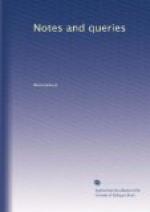* * * * *
THE MIRROR.
(From the Latin of Owen.)
Bella, your image just returns your smile—
You weep, and tears its lovely
cheek bedew—
You sleep, and its bright eyes are closed
the while—
You rise, the faithful mimic
rises too.—
Bella, what art such likeness could increase
If glass could talk, or woman hold her
peace?
Rufus.
* * * * * {309}
Journeyman.—Three or four years since, a paragraph went the round of the press, deriving the English word “journeyman” from the custom of travelling among work-men in Germany. This derivation is very doubtful. Is it not a relic of Norman rule, from the French journee, signifying a day-man? In support of this it may be observed, that the German name for the word in question if Tageloehner, or day-worker. It is also well known, that down to a comparatively recent period, artisans and free labourers were paid daily.
Gomer.
Balloons.—In one of your early numbers you mention the History of Ringwood, &c. Many years since I sent to a periodical (I cannot recollect which) a circumstance connected with that town, which I never heard or read of anywhere, and which, as it is rather of importance, I forward to you in hopes that some of your correspondents may be able to throw some light upon it. When my father was in the Artillery Ground at the ascension of Lunardi’s balloon, he remarked to several persons present, “This is no novelty to me; I remember well, when I was at school in Ringwood [about the year 1757], an apothecary in that town that used to let off balloons (he had no other name, I suppose, to give them) on a smaller scale, but exactly corresponding with what he then saw, many a time.”
I had several letters addressed to me, requesting further explanation, which, as my father was dead, I was unable to give. It is highly improbable that any persons now living may have it in their power to corroborate the fact, but some of their relations or descendants may. I suppose they must have been fire-balloons, and these of the rudest construction; and my father, being a boy at the time, would have given perhaps little valuable information, except as to the name of the apothecary, which, however, I never heard him mention.




